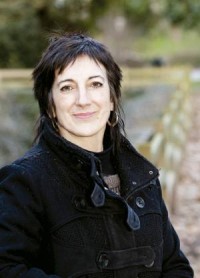"Pinar is a metaphor for the situation of the primary sector"
- On February 5, biologist and member of Naturkone Aitziber Sarobe offered a talk in Soraluze under the title A new forestry policy for Gipuzkoa. The guest talked about pine disease and the jungle crisis, and he gave "keys to understanding what's going on."

What is Naturko?
It is an association that brings together all the naturalist and ecologist groups in Gipuzkoa. It was created in 2011. The government that entered the Council ordered the change and we prepared for that change. At that time we made a reflection: “We have to offer an alternative around forestry, hunting, biodiversity…” But when the new government came, it all stood by.
What is your opinion about the situation created by the disease of pine?
For ten years, we knew that we had come to this stage, both ourselves and the sectors. Some people were surprised at the scale of the problem, because it could not be concealed anymore. After all, underneath, there is the crisis in the whole rural environment. We are living further and further away from the rural world, and pinares show a metaphor for the situation in the countryside and the primary sector.
The pine has given a lot of money and as a species you just need to thank him. Many dwellings have been reformed thanks to the pine. The problem is the pinar management model.
In recent weeks the situation has relaxed, right?
I would not say that it has been reassured. In spring the problem will intensify. People are probably getting used to it. But the problem is going to get worse and the remedies that the administration is doing are not going to give rise to any solution. The affected one cannot recover and the affected one will become ill. This doesn't turn back.
What role does the forestry industry play?
In the last forty years, the forest has been dedicated to producing cheap timber and Basquegur is a group that represents that interest. Today, unfortunately, it is they who direct forestry policies. In addition, even if there are other woods, today in Euskal Herria the solution is difficult because there is no market for it. The sector has focused on a wood of questionable quality of rapid growth: for the paper industry, for light construction…
The most serious consequences of forty years of monoculous, intensive and aggressive implementation are soil impoverishment and loss of biodiversity. You just have to see what the river carries when it rains. The earth is what it brings. Land of hundreds of years of maturation. Losing the land is losing one's life.
What are the owners doing?
The big owners have administration and industry in their favour and are quieter, but the majority, the small landowners, are in shock. There is a lot of lack of information and knowledge. Unfortunately, what is happening more and more is that the land is left behind.
It must be borne in mind that although the industry complains, it has cheap timber for years. It has tons and tons of wood for many years, which will pay almost to zero. The other thing is that of forest owners. Most of them are small forest owners, and this is another burden. Twenty or thirty years have been waiting for the benefit and now the safest thing is that they will have expenses. It's a disaster.
What is the way forward?
From the point of view of nature conservation, we are opposed to this exploitation model and we propose rules and ways to reduce damage to the environment, but from there to saying how the industry should be focused, it is not our job. This work is up to the administration and the opposition parties to build a real alternative.
In this area there is no desire for R & D funding from the Administration. It is clear that in order to solve this problem, other benefits must be brought to the forest. The Administration has to reward that path, but it is not doing so at the moment.
You claim that it is the responsibility of society and that to do so you have to create spaces.
Yes, and the question is where and how to do it. To do this, it is necessary to create networks and modes. How should citizens be involved in this debate? We have not been able to do so in the last four years either. The Member offered us a single meeting in which we were told that they had no interest in developing the Natura 2000 network and doing nothing for nature conservation. They told us that.
We have made requests to the Member. One of our demands is to put an end to this exploitation model and to the aggressive techniques that cause damage, and perhaps one day start penalising it. That is the first thing. And, among other things, in view of the loss that this would entail in the owners, we understand that it is essential to create public participation tables to work different knowledge and interests. There are many experts and from there the exits can come out.
This news was posted by Plaentxia.eus and we brought it to ARGIA thanks to the CC-by-sa license.
Bedaio is celebrated every year on a Sunday of the days when the few and November love each other. One more year, with a table to offer the manual LandarLantzen 2019, made with the great Olariaga, and to try to clarify the questions and doubts of the people. On the left, Koro... [+]
The landscape of pine has been blackened, especially that of pine insignis (Pinus radiata). It's also known as black pine or rapid pine. Black pine, in fact, has blackened the landscape of the mountains in which it has grown, and its pine forests are black at all times of the... [+]























